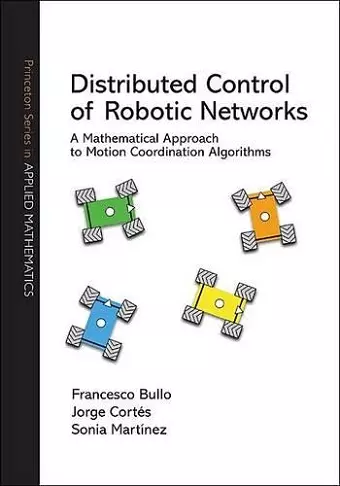Distributed Control of Robotic Networks
A Mathematical Approach to Motion Coordination Algorithms
Sonia Martínez author Francesco Bullo author Jorge Cortés author
Format:Hardback
Publisher:Princeton University Press
Published:14th Jul '09
Currently unavailable, and unfortunately no date known when it will be back

This book covers its subject very thoroughly. The framework the authors have established is very elegant and, if it catches on, this book could be the primary reference for this approach. I don't know of any other book that covers this set of topics. -- Richard M. Murray, California Institute of Technology The authors do an excellent job of clearly describing the problems and presenting rigorous, provably correct algorithms with complexity bounds for each problem. The authors also do a fantastic job of providing the mathematical insight necessary for such complex problems. -- Ali Jadbabaie, University of Pennsylvania The order of presentation makes much sense, and the book thoroughly covers what it sets out to cover. The algorithms and results are presented using a clear mathematical and computer science formalism, which allows a uniform presentation. The formalism used and the way of presenting the algorithms may be helpful for structuring the presentation of new algorithms in the future. -- Vincent Blondel, Universite catholique de Louvain
Introduces the distributed control of robotic networks. This book presents a set of tools for understanding coordination algorithms, determining their correctness, and assessing their complexity. It analyzes various cooperative strategies for tasks such as consensus, rendezvous, connectivity maintenance, deployment, and boundary estimation.This self-contained introduction to the distributed control of robotic networks offers a distinctive blend of computer science and control theory. The book presents a broad set of tools for understanding coordination algorithms, determining their correctness, and assessing their complexity; and it analyzes various cooperative strategies for tasks such as consensus, rendezvous, connectivity maintenance, deployment, and boundary estimation. The unifying theme is a formal model for robotic networks that explicitly incorporates their communication, sensing, control, and processing capabilities--a model that in turn leads to a common formal language to describe and analyze coordination algorithms. Written for first- and second-year graduate students in control and robotics, the book will also be useful to researchers in control theory, robotics, distributed algorithms, and automata theory. The book provides explanations of the basic concepts and main results, as well as numerous examples and exercises. * Self-contained exposition of graph-theoretic concepts, distributed algorithms, and complexity measures for processor networks with fixed interconnection topology and for robotic networks with position-dependent interconnection topology * Detailed treatment of averaging and consensus algorithms interpreted as linear iterations on synchronous networks * Introduction of geometric notions such as partitions, proximity graphs, and multicenter functions * Detailed treatment of motion coordination algorithms for deployment, rendezvous, connectivity maintenance, and boundary estimation
"This book covers its subject very thoroughly. The framework the authors have established is very elegant and, if it catches on, this book could be the primary reference for this approach. I don't know of any other book that covers this set of topics."—Richard M. Murray, California Institute of Technology
"The authors do an excellent job of clearly describing the problems and presenting rigorous, provably correct algorithms with complexity bounds for each problem. The authors also do a fantastic job of providing the mathematical insight necessary for such complex problems."—Ali Jadbabaie, University of Pennsylvania
"The order of presentation makes much sense, and the book thoroughly covers what it sets out to cover. The algorithms and results are presented using a clear mathematical and computer science formalism, which allows a uniform presentation. The formalism used and the way of presenting the algorithms may be helpful for structuring the presentation of new algorithms in the future."—Vincent Blondel, Université catholique de Louvain
ISBN: 9780691141954
Dimensions: unknown
Weight: 851g
320 pages